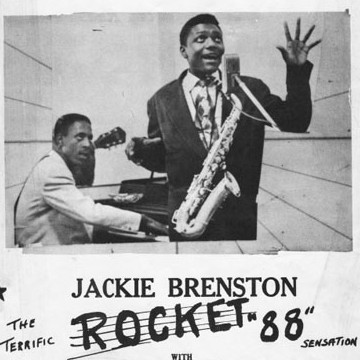The quest to pinpoint the absolute “first rock and roll record” is a journey fraught with debate and subjectivity. Yet, amidst this sonic exploration, “Rocket 88” by Jackie Brenston and the Delta Cats consistently emerges as a pivotal contender. While definitive origins remain elusive, “Rocket 88” is widely recognized as a crucial early rock and roll song, capturing a raw energy and innovative spirit that would define the genre. This article delves into the history of “Rocket 88,” exploring its creation, its key players, and its enduring impact on music history.
 A poster showing Jackie Brenston in front with his saxophone, while Ike Turner glowers at him from the piano in the background
A poster showing Jackie Brenston in front with his saxophone, while Ike Turner glowers at him from the piano in the background
The Claim to Rock and Roll Fame: “Rocket 88” and its Revolutionary Sound
“Rocket 88” wasn’t necessarily groundbreaking in every musical aspect, but it possessed a unique combination of elements that resonated with the burgeoning rock and roll sound. One of the most significant aspects was its distinctive distorted guitar. Accidental though it may have been, this sonic texture became a hallmark of rock and roll, setting it apart from previous genres. Combined with Ike Turner’s driving piano rhythm and Jackie Brenston’s confident vocals, “Rocket 88” delivered a potent and novel musical experience.
To truly understand the significance of “Rocket 88 Song”, it’s crucial to place it within its musical lineage. The song didn’t appear in a vacuum; it drew inspiration from earlier musical trends, most notably the boogie-woogie and jump blues styles popular in the 1940s and early 1950s.
Echoes of the Boogie: The Honeydripper and Cadillac Boogie
Before “Rocket 88” ignited the airwaves, the boogie-woogie sound had already captured the public’s attention. Joe Liggins, a piano player, penned “The Honeydripper” in 1942, a catchy tune that became a massive hit for his band, Joe Liggins and the Honeydrippers, in 1945.
[Excerpt: “The Honeydripper” by Joe Liggins and the Honeydrippers]
“The Honeydripper” showcased a driving rhythm and improvisational feel, laying some groundwork for the rhythmic energy that would later characterize rock and roll. Joe Liggins’ brother, Jimmy Liggins, also ventured into music, forming his own band, the Drops of Joy. While not as commercially successful as his brother, Jimmy Liggins’ B-side track, “Cadillac Boogie,” released in 1947, proved to be surprisingly influential.
[Excerpt “Cadillac Boogie” by Jimmy Liggins and the Drops of Joy]
“Cadillac Boogie” with its automotive theme and energetic rhythm, served as a direct inspiration for “Rocket 88”. The similarities in rhythm and lyrical theme are undeniable, highlighting the evolutionary nature of musical genres.
Sam Phillips and Memphis Recording Service: The Birthplace of “Rocket 88”
To tell the story of “Rocket 88 song” is to tell the story of Sam Phillips. Phillips was a visionary producer with a deep appreciation for raw, authentic musical expression. He established Memphis Recording Service in 1950, a studio that aimed to capture the unbridled energy of musicians, particularly Black artists in the Mississippi Delta region. Phillips wasn’t just interested in technical perfection; he sought to capture the soul and feeling within a performance.
His philosophy was rooted in a desire to break down racial barriers through music. Phillips believed in the power of music to transcend prejudice and showcase the talent and humanity of Black musicians to a wider audience. This conviction drove him to seek out and record artists who were creating music outside the mainstream.
The Fateful Recording Session: Accident and Innovation
In 1951, Ike Turner, leading his band the Kings of Rhythm, was encouraged by B.B. King to connect with Sam Phillips. Turner and his band, including saxophonist Jackie Brenston, drove from Mississippi to Memphis for a recording session at Phillips’ studio. The journey itself became part of the “Rocket 88” legend.
Accounts vary, but the story goes that during the trip, the band’s guitar amplifier was damaged, perhaps due to a flat tire incident. When they set up in the studio, the damaged amplifier produced a distorted, buzzing sound. While the band was initially dismayed, Sam Phillips was enthralled. He recognized the unique sonic texture as something exciting and new. Instead of attempting to repair the amp perfectly, Phillips embraced the distortion, even using brown paper as a makeshift fix to further shape the sound.
The song chosen for that session was “Rocket 88,” credited to Jackie Brenston, though heavily influenced by the musical ideas of the entire band, particularly Ike Turner. The lyrics celebrated the Oldsmobile Rocket 88, a car that symbolized modernity and speed in the early 1950s.
[Insert a chunk of Rocket 88]
Analyzing the Sound of Innovation: The “Rocket 88” Song
“Rocket 88” is more than just a catchy tune; it’s a sonic blueprint for rock and roll. Ike Turner’s piano intro is instantly recognizable and hugely influential. Little Richard famously borrowed this piano riff for his hit “Good Golly Miss Molly,” demonstrating the direct lineage and impact of Turner’s playing.
[intro to Rocket 88]
[intro to Good Golly Miss Molly]
However, the distorted guitar, played by Willie Kizart, truly set “Rocket 88” apart. The buzzing, raw tone was unlike anything widely heard in popular music at the time. Listeners, accustomed to cleaner guitar sounds or the smoother tones of saxophones in R&B, may have even mistaken the distorted guitar for a baritone saxophone. This sonic ambiguity and novelty contributed to the song’s unique appeal and its later recognition as a rock and roll precursor.
Release, Recognition, and Ripple Effects
When “Rocket 88” was released, it was credited to “Jackie Brenston and his Delta Cats,” a move that reportedly angered Ike Turner, who expected the release to be under his band’s name, Ike Turner and his Kings of Rhythm. Despite the controversy over credit, the record became a hit, reaching the top of the Billboard R&B charts.
The success of “Rocket 88” propelled Jackie Brenston into a brief solo career. However, he struggled to replicate the success of his initial hit and eventually rejoined Ike Turner’s band as a sideman. Sadly, Brenston’s later life was marked by alcoholism and a lack of recognition for his role in music history.
For Ike Turner, “Rocket 88” served as a launching pad, albeit with initial setbacks. The song’s success led to half of his band leaving to join Brenston. However, Turner’s association with Sam Phillips deepened. He became a talent scout for Phillips, bringing artists like Howlin’ Wolf to his attention. This connection eventually led Phillips to found Sun Records, a label that would become synonymous with early rock and roll. Turner also learned a valuable lesson about credit and control, later ensuring he was always prominently featured alongside his performers, most famously with Tina Turner.
Beyond the immediate players, “Rocket 88 song” also influenced future generations of musicians. Bill Haley, then a country musician, recognized the crossover appeal of R&B and covered “Rocket 88” with his band, the Saddlemen. Haley’s version is also cited by some as an early rock and roll recording, further cementing “Rocket 88″‘s legacy as a foundational track in the genre’s development.
Conclusion: The Enduring Roar of “Rocket 88”
“Rocket 88” may not be definitively the very first rock and roll record. Musical history is rarely so neatly categorized. However, its significance as a crucial early example of the genre is undeniable. From its boogie-woogie roots to its groundbreaking distorted guitar sound, “Rocket 88” captured a moment of musical transition and innovation. It showcased the raw energy, the automotive-age themes, and the rhythmic drive that would come to define rock and roll.
While the story of “Rocket 88” is intertwined with complex figures like Ike Turner, whose later actions cast a shadow, the song itself remains a vital piece of music history. “Rocket 88” roared onto the scene, leaving an indelible mark and paving the way for the rock and roll revolution that would soon follow.
Resources
Explore further into the world of “Rocket 88” and early rock and roll with these resources:
- Mixcloud Playlist: A History of Rock Music in 500 Songs Supplemental 11 – Rocket 88 – Listen to full versions of songs featured in this article and related tracks.
- Album: Memphis Vol. 3 – Recordings from the Legendary Sun Studios – Hear “Rocket 88” and other recordings from Sam Phillips’ iconic Sun Studios.
- Book: Sam Phillips: The Man Who Invented Rock ‘n’ Roll by Peter Guralnick – Delve into the definitive biography of Sam Phillips and his impact on music history.
- Book: I, Tina by Tina Turner with Kurt Loder – Read Ike Turner’s perspective on the recording of “Rocket 88” within Tina Turner’s autobiography.

